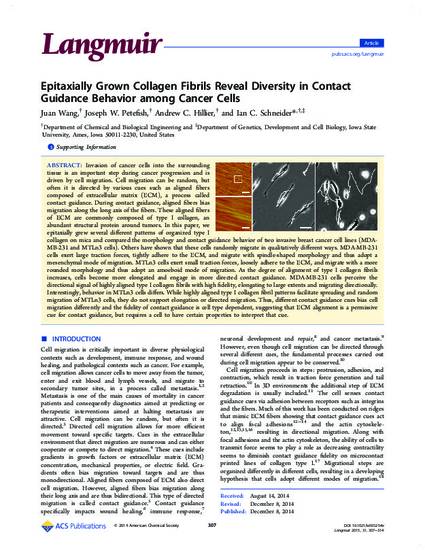
Invasion of cancer cells into the surrounding tissue is an important step during cancer progression and is driven by cell migration. Cell migration can be random, but often it is directed by various cues such as aligned fibers composed of extracellular matrix (ECM), a process called contact guidance. During contact guidance, aligned fibers bias migration along the long axis of the fibers. These aligned fibers of ECM are commonly composed of type I collagen, an abundant structural protein around tumors. In this paper, we epitaxially grew several different patterns of organized type I collagen on mica and compared the morphology and contact guidance behavior of two invasive breast cancer cell lines (MDAMB- 231 and MTLn3 cells). Others have shown that these cells randomly migrate in qualitatively different ways. MDA-MB-231 cells exert large traction forces, tightly adhere to the ECM, and migrate with spindle-shaped morphology and thus adopt a mesenchymal mode of migration. MTLn3 cells exert small traction forces, loosely adhere to the ECM, and migrate with a more rounded morphology and thus adopt an amoeboid mode of migration. As the degree of alignment of type I collagen fibrils increases, cells become more elongated and engage in more directed contact guidance. MDA-MB-231 cells perceive the directional signal of highly aligned type I collagen fibrils with high fidelity, elongating to large extents and migrating directionally. Interestingly, behavior in MTLn3 cells differs. While highly aligned type I collagen fibril patterns facilitate spreading and random migration of MTLn3 cells, they do not support elongation or directed migration. Thus, different contact guidance cues bias cell migration differently and the fidelity of contact guidance is cell type dependent, suggesting that ECM alignment is a permissive cue for contact guidance, but requires a cell to have certain properties to interpret that cue.
Available at: http://works.bepress.com/andrew_hillier/42/

Reprinted (adapted) with permission from Langmuir 31 (2015): 307, doi: 10.1021/la503254x. Copyright 2015 American Chemical Society.